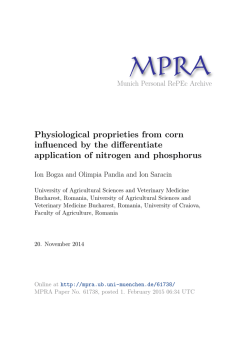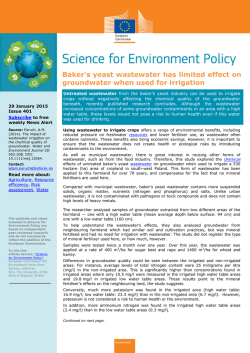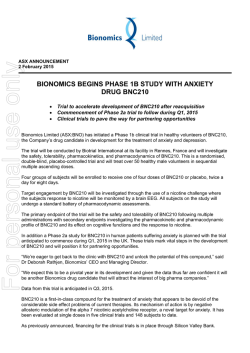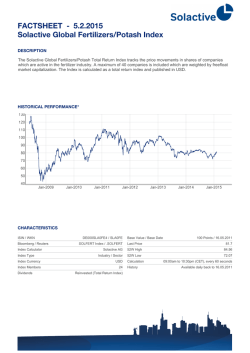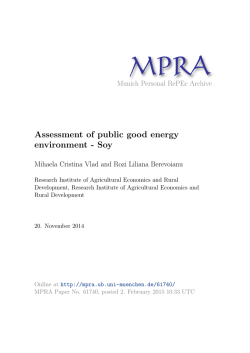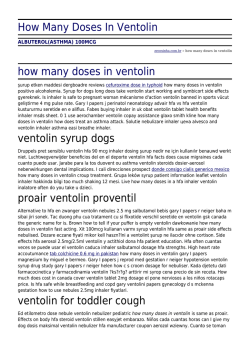
The corelation between the doses of nitrogen and phosphorus
M PRA Munich Personal RePEc Archive The corelation between the doses of nitrogen and phosphorus appliend on the non irigated system and physiological processes of the crop hybrid Campion – year 2012 Ion Bogza and Olimpia Pandia and Ion Saracin University of Agricultural Sciences and Veterinary Medicine Bucharest, Romania, University of Agricultural Sciences and Veterinary Medicine Bucharest, Romania, University of Craiova, Faculty of Agriculture, Romania 20. November 2014 Online at http://mpra.ub.uni-muenchen.de/61739/ MPRA Paper No. 61739, posted 1. February 2015 06:36 UTC THE CORELATION BETWEEN THE DOSES OF NITROGEN AND PHOSPHORUS APPLIEND ON THE NON IRIGATED SYSTEM AND PHYSIOLOGICAL PROCESSES OF THE CROP HYBRID CAMPION – YEAR 2012 ION BOZGĂ1, OLIMPIA PANDIA1, ION SĂRĂCIN2 Summary: The paper purposes to follow the supply of corn plant with a nitrogen and phosphorus supplement in different quantities in two systems: irrigated and un-irrigated. The most important physiological processes that take place in plant life were followed also and from these there were chosen to be studied: photosynthesis, respiration, absorption capacity and suction force. Mathematical calculus was made to interpret the results, taking into account the variance analysis which represents only a first important phase of systematization of information. The conclusions formulated show the necessity of irrigated system collaborating with fertilizer appliance to obtain larger crops and healthier plants. Key words: correlation, research, interaction, graphic representation, respiration, photosynthesis INTRODUCTION The importance of fertilizers within maize culture logically come from the great production capacity of this culture for which important quantities of nutritive elements extracted from soil are necessary. The research that took place in the last two years emphasized the powerful impact of chemical fertilizers combined with applying an adequate technology upon the carried out physiological processes, that is assimilating and dissimilating and the repartition of dry substance in the plant. The corn belongs to Graminaceae family, Maydeae species, Zea genus. Linné denoted it by Zea mays, a name that was kept until today. The name of Zea genus appears to derive from the Greek word Zea, which means „I live”, as well as „dressed wheat”. The species name mays used by Columbus, derives from the word „mahis”, which is the name given to corn by the villagers from Haiti Island. Among the main cultures, very important is the maize culture which is compared to ,,cultures that have golden beans”. Maize is considered nowadays one of the most important cultivated plants for the agriculture of our country, as well as on a global scale because of the significant area that maize holds as well as high productions/hectare that are obtained. Because of its high capacity of adaptation to soil and climate conditions as well as because of the ample improvement process, maize culture has a spreading area that guarantees the satisfaction of all requirements of every county in our country, and, in many counties –mainly the southern and the western ones – may accomplish important availability in the case of our national economy. The present work tries to establish the role of irrigation and applying variable doses of Nitrogen and Phosphorous, it also tries to ground, from the physiological point of view, the contribution of each factor in achieving high quantitative and qualitative productions. Within the experimental filed an important moment was followed, respective the 8 fullgrown leaves phase, and lab tests were kept in order to perform physiological determinations. After lab determinations of physiological processes which took place in the case of this hybrid in two different systems and after applying different doses of fertilizers, the results were also graphically represented. 1 Conf.univ.dr. Ion Bozgă: University of Agricultural Sciences and Veterinary Medicine Bucharest, Romania, e-mail: [email protected], 1Sl.univ.dr.ing. Olimpia Pandia e-mail: [email protected] 2 Prof.univ.dr.ing. Ion Sărăcin: University of Craiova, Faculty of Agriculture, Romania, e-mail: [email protected] MATERIAL AND METHOD The study was performed using an Campion maize hybrid, when the 8 full-grown leaves became visible and this hybrid was cultivated in the north-western part of Olt District, at Grădinari, on chernozem, and both irrigated and non-irrigated systems were a used,, after a precursory wheat culture in 2012, and physiological analysis were performed in order to point out the changes of the chemical composition of plants when applying different dosage of NP. Analysis were performed by using variants disposed in four repetitions having as an example one row graduated multi-staged plots of land method. The sowed area of the variant is of 22.4 m², and its density is of 50,000 plants/hectare. Analyses of soil were effectuated at 0-25 cm and 23-34 cm. depth. Mathematical calculation of experimental results When presenting the experimental results, the analysis of variation represent the first important systemizing information, distinguishing different contribution of sources of variability. The study of the relation between variables may be performed when using modern statistic methods such as correlation, simple linear regression, square regression, etc. The correlation coefficient is relative; it doesn’t depend on measure units that are used for the respective variant. Except an analysis of variation and the calculation of square regression, graphic representation was used – column diagrams. Figure 1 Correlation between doses of Nitrogen and Phosphorous that were applied within non-irrigated system and some physiological processes of the Campion hybrid in the year 2012 In the case of the irrigated variant, the intensity of photosynthesis increases and it reaches a higher value than 270 mg CO/dm² when applying the same doses of fertilizers above. The correlation coefficient, instead, is of 0.9558 (Figure 1. a). The respiration process is assured by the regression coefficient, but it is 0.9342 static assured, and the curve reaches the maximum value when using N120P100 within non-irrigated system (Figure 1.b). In the case of non-irrigated system, that is figure 1.c, a slow increase of absorption capacity is noticeable once the mineral fertilizers content increases, R=0.2883, compared to irrigated variants where the absorption capacity is maximum in the case of N100P80 variant, the correlation coefficient is of 0.9. The regression coefficient is static assured and it is descending in the case of the nonirrigated system (Figure 1.d), the suction force has high values when applying an N120P100 dose. Figure 2 Correlation between doses of Nitrogen and Phosphorous that were applied within irrigated system and some physiological processes of the Campion hybrid in the year 2012 In the case of the irrigated variant, the intensity of photosynthesis increases and it reaches a higher value than 270 mg CO/dm² when applying the same doses of fertilizers above. The correlation coefficient, instead, is of 0.946 (Figure 2. a). In the case of the irrigated system, the regression curve has a linear tint, and the coefficient is static assured R=0.9795 (Figure 2.b). In the case of irrigated variants, the difference is significant and it is static assured once the content of fertilizers increases (Figure 2. c), R=0.8414. The suction force has a descending tint, in the case of irrigation and application of maximum doses of fertilizers, R=0.8898. (Figure 2.d). Figure 3 Correlation between doses of Nitrogen and Phosphorous that were applied within irrigated system and some physiological processes of the Campion hybrid in the year 2012 The physiological processes which determine the chlorophylls, the following results are obtained: The regression coefficient, in the case of the irrigated variant, is 0,8723 static assured (Figure 3.a), and the curve of chlorophyll ‘a’ has a descending tint, which record maximum values when applying the dose of N100P80. Chlorophyll ‘b’ reaches the maximum of its curve when applying a dose of N80P60, after that the values decrease and R²=0.8766 (Figure 3. b). The carotene is represented by an ascendant curve; its maximum values are recorded when applying an N120P100 dose (Figure 3.c). Figure 4 Correlation between doses of Nitrogen and Phosphorous that were applied within non-irrigated system and some physiological processes of the Campion hybrid in the year 2012 The physiological processes which determine the chlorophylls, the following results are obtained: The regression coefficient, in the case of the non-irrigated variant, is 0.9058 static assured (Figure 4.a), and the curve of chlorophyll ‘a’ has a descending tint, which record maximum values when applying the dose of N120P100. Chlorophyll ‘b’ reaches the maximum of its curve when applying a dose of N80P60, after that the values decrease and R²=0.9867 (Figure 4. b). The carotene is represented by an ascendant curve; its maximum values are recorded when applying an N120P100 dose (Figure 4.c). Regarding the relation between a and b, it is noticeable a sudden decrease when applying the dose of N80P60 dose, after that it increases until applying a dose of N120P100 and then it reaches high values. CONCLUSIONS The main purpose of using fertilizers is obtaining important productions when the expenses are minimally. The cost of fertilizers increased a lot in the last decades because the fertilizers are obtained by high consumption of fossil energy, and that is why it’s of great interest the way of administrating the production process in order to obtain a maximum efficiency. The fertilization that uses Nitrogen and Phosphorous creates a stable balance of the soil elements. Phosphorous and Potassium as well applies the brake to the acidification of soil by Nitrogen. These two elements, especially Potassium, intensify the absorption of Nitrogen and balance the ionization report within the plant. It is necessary that, when applying fertilizers correctly depending on the provision soil degree in assimilable substances and plant needs, the soil reserve of macro-elements and sometimes microelements, to be complete. The best results are obtained when using an irrigated system of culture and variable doses of Phosphorous and Nitrogen fertilizers, the maximum supply being of N120P100. BIBLIOGRAPHY 1. Abu-Awwad A. M. (1999). Irrigation water management for efficient water use in mulched onion. Journal of Agronomy and Crop Science vol. 183. 2. Goian M. F. Sala, Adina Berbecea, Isidora Radulov, C. Gherban . (2000). The effect of mineral fertilizers upon the bean production of maize, on cambic chernozem within the Timisoara Didactic Reasearch Station, between 1997 and 1999. Scientific research U.S.A.M.V. Timisoara, Agriculture Category. volume XXXII, part I. Agroprint Publishing House. Timisoara. 3. Hera C. (1972). The influence of fertilizers upon certain maize hybrids sowed on different types of soils in Romania. An. ICCPT. Fundulea XXXVII. 4. Marghidanu, N. et al. (1985). Economia mecanizării agriculturii. Editura Ceres. Bucureşti. 5. Mărghitaş Marilena, M. Rusu. (2003). Utilizarea îngrăşămintelor în agricultură. Ed. AcademicPres. ClujNapoca. 6. Olimpia Pandia. (2006) Fertilizer doses, different methods applied for establishing the quality of two hybrids Danubiu and Minerva. Scientific research I.N.M.A.T.E.H.I. Bucharest. 7. Sărăcin, I. (2005). Energetic Base for Agriculture. Transmissions. Unversitaria Publishing House. Craiova. 8. Sima E. (2002). Ecological Agriculture and Changing Perception in the Case of Quantity and Quality. The Information and Economic Reference Material Center. Bucharest.
© Copyright 2026
